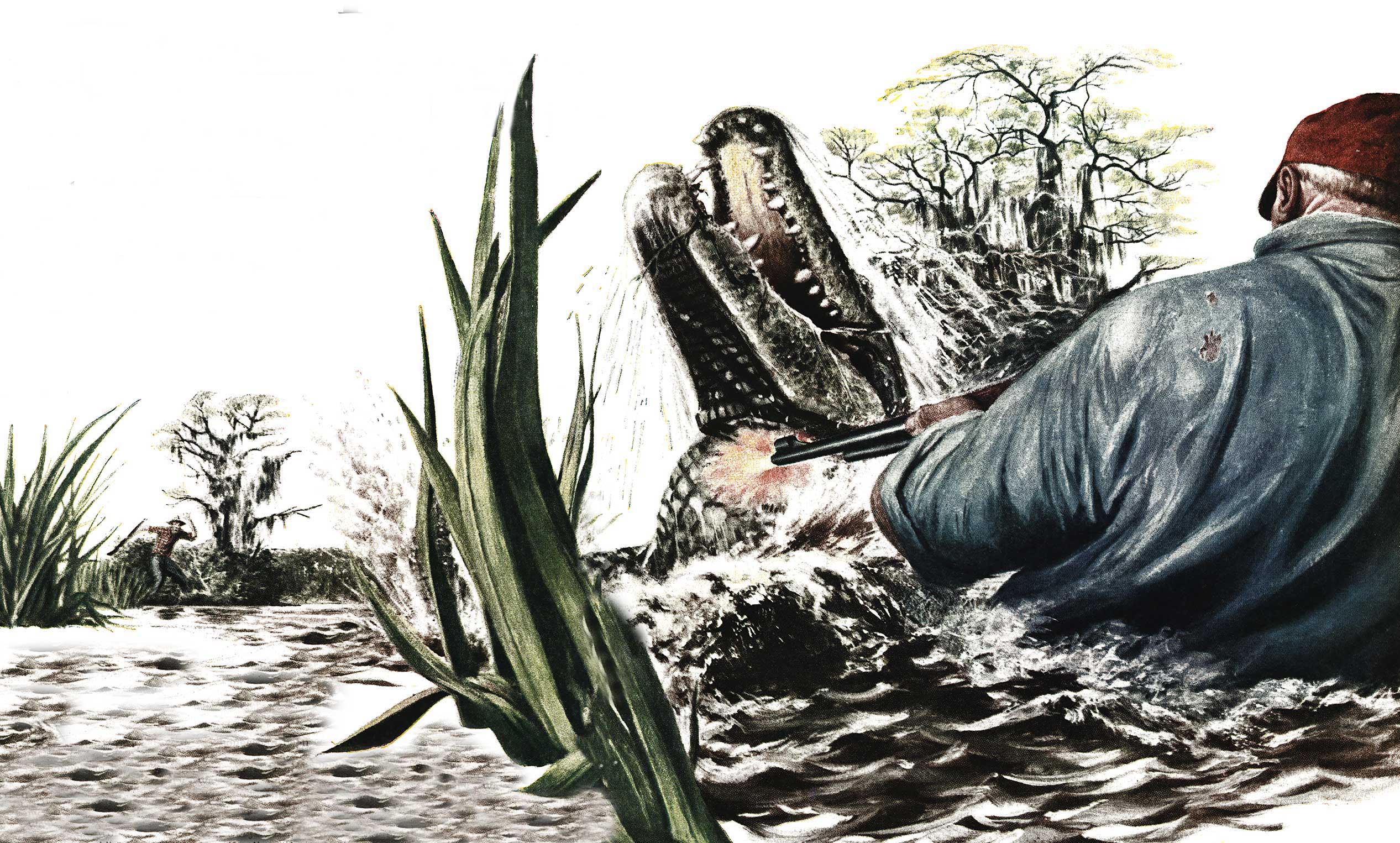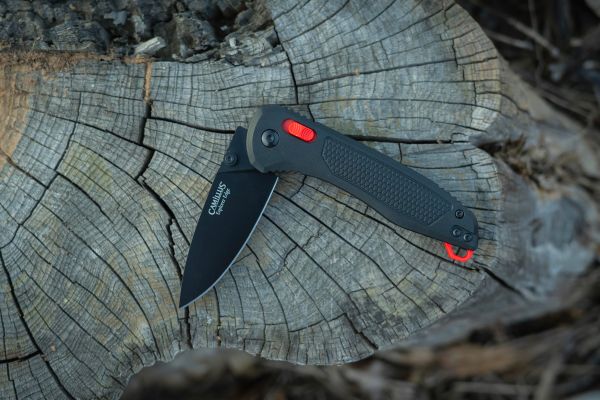With the possible exceptions of the rattlesnake and the bald eagle, the North American alligator has been the victim of more nature faking than any other creature on the continent. For one thing, fourteen- and fifteen-foot man-killers are by no means uncommon in adventure fiction. But the largest American alligator I’ve ever measured stretched just 12 feet 8 inches, and he was a patriarch. However, I once was fishing Lake Griffin, near Leesburg, Florida, when a heavy concentration of buzzards on the bank caught my attention. Thinking some cow had mired down and died, I went ashore and found the decomposing body of what I feel sure would have proved a record for alligators in this country. It had reached the stage where it held a strong appeal for turkey buzzards, and measuring the body was a job I didn’t crave. As well as I could gauge from a safe distance upwind, that gator was as long as my sixteen-foot boat, but I didn’t get an accurate measure. When I returned after a month, even the bones had been scattered by the scavengers.
Several years ago a popular, though far-fetched, story was making the rounds. It concerned a fellow, slightly the worse for wear, who felt a yearn to philosophize with his bartender about the wonders of nature. “Do you un’erstan’,” he stated with authority, “that there’s literally millions of female alligators in the South? An’ do you un’erstan’ that every year every one of those female alligators lays thousan’s an’ thousan’s of eggs?” The bartender tsk-tsked at the marvel of it all. “An’ did you ever know,” the happy one continued, “that papa alligator hangs aroun’ an’ eats up most of his babies jus’ as fast as they’re hatched?” The bartender clucked his disapproval of such parental perversity. “But it’s a good thing,” the philosopher allowed, “for if it wasn’t for those papas you an’ me an’ all our friends would be up to our ears in alligators.”
That worried raconteur was no further off than many writers who seriously attribute to our North American alligator a cunning and a ferocity which he plainly doesn’t possess.
Strange as it is, the true alligator inhabits only two relatively small sections of the globe: a minor district in China, and a part of the United States ranging from south Florida, up through parts of North Carolina, and west to Texas. His close cousins, the caymans and the crocodiles, however, practically girdle the earth.
The greatest difference between the gator and the crocodile is in a matter of disposition. The croc is a bad actor and doesn’t care who knows it, whereas the gator possesses a healthy respect for man. Physical differences lie in the contrast between the broad, flat head of the gator as opposed to the croc’s tapering snout. Too, the long fourth tooth of the gator fits into a socket in the upper jaw, while the corresponding tusk of the crocodile lies in a groove and is visible above the snout when the jaws are closed.
Alligators mate in early spring, and the 40 to 60 eggs resulting from the union are laid on the banks of stream or pond. They are buried in layers, with vegetation placed between. Heat generated by the decaying foliage takes care of incubation, but the mother gator hangs around the nest until the young eat through the eggshells with a special tooth nature has provided for that purpose.
The only times I have ever been charged by a gator were when I accidentally stumbled on a nest. The mother gets all set for war when that happens. She comes crashing through the underbrush like a miniature low-slung tank, puffing and blowing and popping her jaws. But I’m convinced, though not to the point of testing my theory, that her actions are 90 percent bluff.
Ross Allen, who runs the Reptile Institute at Silver Springs, Florida, and who possibly knows more about alligators in their natural state than any other man living, tells me that an old bull gator courting his ladylove in the water, is a sight to behold. He sinks his head beneath the jaws of his girlfriend and gently blows bubbles against her chin. It seems to work.
Back in the late ’20’s, when the Tamiami Trail in Florida was nearing completion, thousands of gators fished in canals bordering the highway. Last year I drove over the trail and counted exactly two. Trigger-happy tourists are mainly responsible; many a wounded gator has dragged off to die miserably in the Everglades. The wild alligator in Florida might even have become extinct had not some legislators acted to preserve the state’s wildlife resources.
Twenty-five years ago I knew a dozen men who eked out a living by gator hunting. Today I know just one old man who depends on it for a livelihood, and he gets by mainly on grits and grunts. Commercial alligator farms take care of the limited demand for hides and for baby gators as well, where the lamentable practice of selling them as souvenirs hasn’t been outlawed.
Most farms, however, exist principally as “tourist traps,” spots where the visitor may have his picture taken against a painted background with sluggish gators lying at a safe distance from his feet. Even such “adventuring” can have its hazards, though. The proprietor of one farm had a 12-foot gator which he’d tamed. He’d let tourists perch on its back for photos, though I told him once that I’d just as soon sit on a buzz saw. “Why shucks, Jawn,” he allowed, “hit ain’t in no wise dangerous. That old gator’s too plumb lazy to do anything about it.”
But my skepticism was justified, for a couple of years ago that same wild-caught gator roused up enough to grab the owner by the arm and twist it off. The man died before a doctor arrived.
If I had a dollar for every story I’ve read about the ferocity and vitality of alligators I’d be fixed for life. I’ll grant them a certain amount of vitality, but I’ve never seen an actual instance of ferocity.
Once I thought I’d found a gator that was definitely on the prod. We were fishing in Georgia’s Altamaha River below Darien a few miles above where it flows into the Atlantic. Before we started out one of the local men asked if we intended going by the “redbluff drop” to fish. When I said we might, he told me a big, mean gator had been hanging out thereabouts. “Last week,” he said, “I was throwing my cast net for mullets, and that scudder come at my bateau. If’n I hadn’t give him lots of room, I do declare he’d of took it away from me.”
We hadn’t been fishing long at red-bluff drop when Bill rose from his seat and peered downstream. “Ain’t that a big gator drifting in on the tide?” he asked. I looked, and sure enough, a hundred feet from our boat I spied the triangled knobs marking the snout and eyes of what looked like a 10-footer, swimming awash. I didn’t want to kill him, so I rapped on the gunwale with an oar and stamped on the bottom of the boat, expecting him to fade away. Instead, he put on speed and headed for the boat. Fun was fun, but I couldn’t see him taking his place in the skiff with us, so I shot him six times with a .38 Special at 15 feet. A week or so later a fisherman found a dead 10-foot crocodile stranded on a mud flat, bullet holes in his head. In 30 years of southern bog-trotting, that has been my only encounter with a croc.
I once was gator hunting in South Georgia with a friend called Tiny. I’d shot a five-footer and waded into the pond to get him, taking my rifle with me. Tiny stood on the bank directing me as I felt around for the dead gator with my feet. Suddenly Tiny shouted and I turned, waist deep in water, to see a big gator headed directly for me on the surface. He must have been lying in the reeds on the bank, and Tiny’s shouting convinced him it was time he got out of there. I started shooting as fast as I could while Tiny jumped, waved his arms, and yelled frantically.
At the fourth or fifth shot, most of them misses, the gator discovered where they were coming from, and he all but turned a back somersault to change direction. He was so close that the wave he made washed almost up to my neck. When I reached the bank I found that Tiny’s fuss hadn’t been caused by any solicitude for me. My rifle’s muzzle had been at such an angle to the pond’s surface that every one of those bullets had ricocheted from the water and zipped by Tiny’s head!
A South Georgia neighbor once asked me if I’d thin out the gator population in a stream running through his place. He had nothing against them, but they had become a menace through their fondness for his shoats. Whenever a young hog got close to the creek’s edge, a gator nabbed him.
Right here, let me say that while I’ve seen a gator grab his prey only twice, I’ve always taken with a shaker full of salt the claim that he uses his tail as a flail to knock his quarry into his jaws. I saw one take a young kid on the banks of the Withlacoochee River, and that one surely didn’t use his tail. He made a diagonal rush at the kid, seized it in his jaws, and plunged into the water.
Now, alligators are nocturnal feeders, and the most deadly method of hunting them is fire-hunting by night. The hunter sits in the bow of his boat, a skilled paddler at the stern. The hunter wears a spotlight on his hat, directing its beam along the banks of the water as he is silently paddled along. When the beam reflects from a gator’s eyes, the eyes first show up as a red bar, then separate into two greenish spots as the distance diminishes. The light seems to hypnotize gators, for they will lie in its beam long enough to permit a quiet boatman to put a gunner practically on top of them.
Since the hunt to save my friend’s hogs was business, I hired as a helper John Life, a swamp dweller who knew gators, could think like a gator, and who some people thought looked like one. I wore a reflector and bulb attached to my hatband, with a wire running to a box of dry cells on the skiff’s floor boards.
You need a dark, moonless night for fire-hunting, and that’s always appealed to me. The still marshlands, bordered by moss-draped live oaks, are mysterious in the blackness, and the dark, cypress-stained waters merge with the night. Over all hangs the smell of the marsh, combining salt tang and wet earth. There is no sound other than the splash of a jumping mullet and the occasional distant whickering of coons hunting.
We’d shined and killed two small gators and dragged them into the skiff when the light picked up a 12-footer some distance out from shore. He lay on the surface as we drifted down, but when we were within 20 feet of him he began to sink. His head couldn’t have been more than a quarter of an inch beneath the surface when I shot, and I could scarcely miss at that range. He turned on his back, and I sank the gaff home. John Life helped me to drag him into the skiff, and we slid him along the floor boards under the thwarts, head toward my seat in the bow.
Some distance on, I shot another of the critters, and was waiting to get close enough to use the gaff when John Life shouted a warning. Simultaneously I heard a shuffling on the floor boards, and swung the light behind me. I caught the open jaws of the big gator as he revived and started straight ahead, blowing a hiss that sounded like a dozen mad cottonmouth moccasins. I hesitated to shoot, for I didn’t want to blow the bottom out of the skiff, but I wasted no time sprawling up on the gunwales. But in scrambling from my seat I jerked the wire loose from the batteries. The light went out. It was blacker than the heart of a goat, and I could hear the gator coming closer. His horny back scraped my foot. As I tried to squeeze myself smaller and smaller he passed under me, and splashed over the bow.
Once I was loafing at an orange grove on Merritt Island in the Indian River. Pickers were gathering the crop, and one noon I heard a terrible hullabaloo in the grove. When I went to investigate, the pickers told me that there was a big gator in one of the irrigation ditches. I went back to the house, got a pistol, and, chasing the excited pickers back from the ditch, waited awhile before starting to try to “grunt” the gator up.
Grunting sometimes will bring gators to the surface, especially young ones or those that haven’t been hunted much. It consists of a series of onnnnhh, onnnnhh, onnnnhh sounds produced from the diaphragm with the mouth open.
Don’t ask me how gators hear the grunts while submerged, but they do. After ten minutes of grunting a gator surfaced. As soon as his eyes broke water I smacked a bullet into him, and he rolled over, feet up. I waded in, grabbed him by the tail, and dragged him on the bank. He was about five feet long and in good condition so I skinned him, tanned his hide, and presented it to my host.

Though gators habitually hibernate during cold weather, even in the Deep South, they may come out now and again when it warms up. Local legend has it that a gator will swallow pine knots before going into winter quarters, just to give his digestive juices something to work on while he’s dormant. Perhaps so, for I’ve opened up gators and found pine knots in their stomachs; but I suspect it was all due to dumbness, not foresight. A gator will snap up almost anything that looks edible, and those pine knots could have been swallowed by mistake.
One November I was hunting quail with a little pointer in the Fish River section of lower Alabama. She found four coveys before I stopped for lunch. The weather was fairly snappy, and the pointer was still full of zip despite the miles of country she’d ranged. We cut in toward the river, and I was looking for a spot to rest when she froze on point. I walked in, flushed the covey, and downed one bird.
The bird fell into the river a short distance away and began to float away on the gentle current. The dog looked eagerly at me, waiting my command to fetch. I knew there were some big gators in the river, and I’m aware of a gator’s great love for dog flesh, but it didn’t occur to me that any would be on the prowl at that time of year. I waved the pointer in, telling her to fetch.
She hit the water and started after the drifting bird. Gathering it up without a pause, she turned and headed for the bank. Then it happened. Right behind her a gator broke the surface, and his gaping jaws closed on her. He sank before I could move.
Before that experience I’d been reasonably tolerant of gators, though I couldn’t see much to admire in them. But when that Fish River gator killed my bird dog my tolerance turned to hate. I set out to get that gator.
I tried fire-hunting him first, without results. I spent hours in ambush on the riverbank in the vain hope that he was still cruising around. I baited sharp hooks with dead chickens and suspended them from poles so that the bait floated just at the surface. No dice. It was a local guide who suggested a ruse which finally brought about the gator’s downfall.
I took a hound puppy to the river and tied him to a stake 20 feet from the water’s edge, right where my pointer had entered the river. I left him, making plenty of noise breaking through the undergrowth as I went. Then I sneaked back, downwind from him, and hid in a palmetto clump within sure-shot range. As I expected, the pup was anything but happy over being tied up in a strange place, and it wasn’t long before he became vocal about it, sending his voice wailing out across the water. There was enough lament in his voice to contract the heart of a man — and the stomach muscles of a hungry gator.
Read Next: The Backstory to the Most Epic Gator Hunting Video on the Internet
I’m positive the same gator that got my pointer came drifting in toward shore, his attention centered on the unsuspecting pup. There wasn’t much likelihood of two gators that size occupying the same stretch of river. I blew off the top of his skull with a .30/30 soft-point bullet, and left him in the water. He was about 10 feet long, and if the old guide at the St. Augustine alligator farm is right about their longevity, I cut him off in his prime.
The showpiece of the St. Augustine farm is a tremendous gator, fully 13 feet long, familiarly known as Ponce de Leon. On my last visit to the farm, the lady with me watched old Ponce as he raised up on his stumpy legs and inched across his pen. “What makes him move so slowly?” she asked the guide. “Lady,” he replied, “them things lives to be hundreds of yeahs old, and if you had hundreds of yeahs to do what you’s got to do, you’d move slow, too.”
I’ll still keep on doing my part to guarantee that Ponce retains the distinction of being the oldest gator in the South.
Read the full article here




